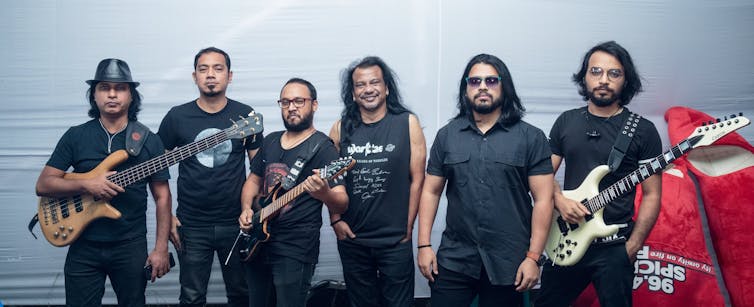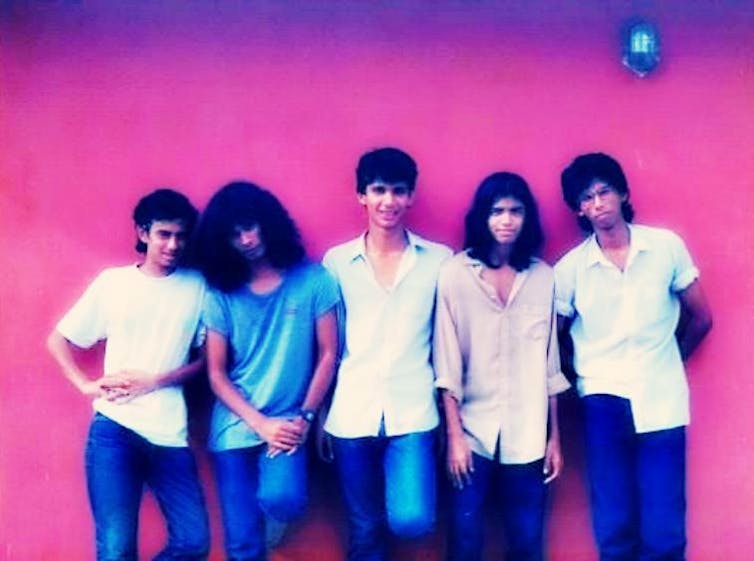
Mubashar Hasan, University of Oslo
The seeds of rock ‘n’ roll culture were planted in Bangladesh during the birth of the country in 1971, after a war for liberation separated this majority-Muslim territory from Pakistan.
For most of the 20th century, the region was a traditional Southasian agrarian society. Its soundtrack: Bengali folk music, featuring instruments like the tabla drum set, harmonium pump organ and the ek tara, a one-stringed guitar.
Then came a bloody war for freedom. And that political rebellion allowed some musical rebellion to take root, too, as my historic research in the country shows.
Rock spurs social change
After independence, a handful of Bangladeshi performers – top among them Azam Khan, a freedom fighter-turned-musician – began looking West for artistic inspiration, listening to Jimi Hendrix, George Harrison and The Doors.
Khan’s band Uccharon introduced drums, guitars and keyboards into their renditions of local music. Bangladeshi audiences had never heard anything like it. With his long hair, bell-bottom jeans, stadium concerts and powerful lyrics – which often delivered a social and political message – Khan became a pop culture phenomenon.
In one famous track from 1970s, “Bangladesh,” Khan paints a grim picture of his young nation, which was gripped by extreme poverty and famine.
He sings of a boy “born in a slum near the rail lines” whose death leaves “his hopeless mom crying.” Throughout the melancholic, guitar-driven song, Khan depicts the desperation of Bangladesh’s early years, punctuating his lament with cries of “Oh, Bangladesh!”
Khan, who died in 2011, influenced a generation of young Bangladeshis to critically reflect on their country’s traditions.
As in the United States a decade prior, where rock music helped change cultural values about race, religion and sexuality, Bangladeshi rock ‘n’ roll – dominated by Azam Khan’s star power – showed people that a different life was possible.
Khan “was a rebel to the dominant culture,” said one man I interviewed, who saw Khan live in the 1980s. He traded his traditional Bengali garb for jeans, he said, because “I saw Azam Khan used to wear jeans.”
The changes Khan pushed went beyond aesthetics.
“He was redefining Bangladeshi culture and promoting liberal values like freedom,” the man told me. “Freedom from conservative values.”
As another fan said, “We were becoming politically aware.”
Bangladeshi rock goes mainstream
Political awareness was a subversive thing in newly independent Bangladesh.
Throughout the 1980s and 1990s, the government alternated between military dictatorship, illiberal democracy and autocracy. And though rural development spurred some economic growth, 41 percent of Bangladeshis still lived in extreme poverty by the early 1990s.
Founded as a secular nation, Bangladesh – which has a Muslim population bigger than that of Saudi Arabia, Iran and Egypt combined – adopted Islam as its state religion in 1988.
That decision, which the nation’s highest court upheld in 2016, made Bangladesh more socially and religiously conservative.
Rock culture was a kind of alternative universe – one where criticism of the government was encouraged and religious zealotry was uncool.
Guns N’ Roses, Pink Floyd and Aerosmith all became popular in Bangladesh in the 1990s. Local groups with English names – the metal pioneers Rockstrata, hard-rocking Warfaze, the popular Love Runs Blind and a dozen others – performed to stadiums full of long-haired fans wearing tee shirts, boots and chain necklaces.

Mahbub19702002/Wikipedia, CC BY-SA
This was revolutionary in a place where musical performances were historically quiet, calm and disciplined.
Rock concerts were loud. Fans smoked cigarettes, headbanged, and got in fights. Artists used alcohol, marijuana and other drugs, if not as heavily as their American or British counterparts.
A rock democracy
As Bangladesh’s economy opened up to the world in the late 1990s – its textile exports leaving the country while Hollywood films and luxury vehicles flowed in – inequality also rose quickly, particularly in rapidly growing cities, where poverty persisted and new wealth accumulated.
Bangladeshi rockers were unsparing critics of these disparities.
In the 1998 track “Dhushor Manchitro,” or “Faded Map,” the metal band Warfaze sings of a “hopeless time,” with “dead bodies on the street every day” and “arrogant blue Mercedes” rushing past, “democracy winking” at the injustice.
In the 1997 track “Gonotontro,” or “Democracy,” singer Maqsood O’ Dhaka calls Bangladesh’s democracy a “constitutional thugocracy.”
Rock artists also denounced Bangladesh’s growing religious conservatism.
In the video for his anti-militancy song “Parwardigar,” Maqsood O’ Dhaka opens with an anti-extremist message. Over images of terrorist attacks and peace rallies, he insists that “blind fanatics and fundamentalists simply cannot snatch away our future.”
The decline of Bangladeshi rock
Most of those social and economic problems have only worsened since then.
Prime Minister Sheikh Hasina, who took power in 2008, has overseen some remarkable economic development. Today, Bangladesh is a manufacturing hub with a booming economy.
But while there’s good news economically, Hasina’s administration has suppressed dissent in Bangladesh.
In the past year, two outspoken government critics – the photographer Shahidul Alam and sociology professor Maidul Islam – were jailed for spreading “propaganda and false information,” a charge that carries up to 14 years in prison.
The nonprofit group Human Rights Watch has called on Hasina’s government to stop the arbitrary arrests of opposition activists. Bangladesh’s prisons reportedly house thousands of people charged with “subversive activities.”
Religious extremism is also rising in Bangladesh. Since 2013 a string of violent attacks targeting secular bloggers, artists, religious minorities and free thinkers has shown the narrowing scope of civil liberties and acceptable public discourse.
The decade the music died
Bangladeshis could use a protest music like rock. Instead, rock culture is fading away.
Partly, it has lost ground to Bollywood music from neighboring India, with its colorful power anthems celebrating life and love. Bollywood songs dominates Bangladeshi radio, and pirated versions are available online for free.
Meanwhile, a budding underground hip-hop scene has largely replaced rock as music of Bangladeshi rebellion.
Domestic law has also failed to protect the financial interests of the artists who once drove Bangladesh’s vibrant rock scene. Industry groups say that just 10 percent of music in Bangladesh is purchased legally and estimate that music piracy annually costs US$180 million in lost earnings.
“Ideas such as intellectual rights and royalties are not strongly embedded in our culture,” Samir Hafiz, Warfaze’s guitarist, told me. “It’s really difficult to live as a rock musician in Bangladesh.”
Increased religiosity, which rejects all things Western in favor of a traditional lifestyle, has also hurt Bangladesh’s rock scene. Some young Muslims I spoke with even see rock ‘n’ roll as a sin.
Rock music helped change Bangladesh. Now, there’s little room left for it.![]()
Mubashar Hasan, Postdoctoral Fellow, Department of Culture Studies and Oriental Languages, University of Oslo
This article is republished from The Conversation under a Creative Commons license. Read the original article.
